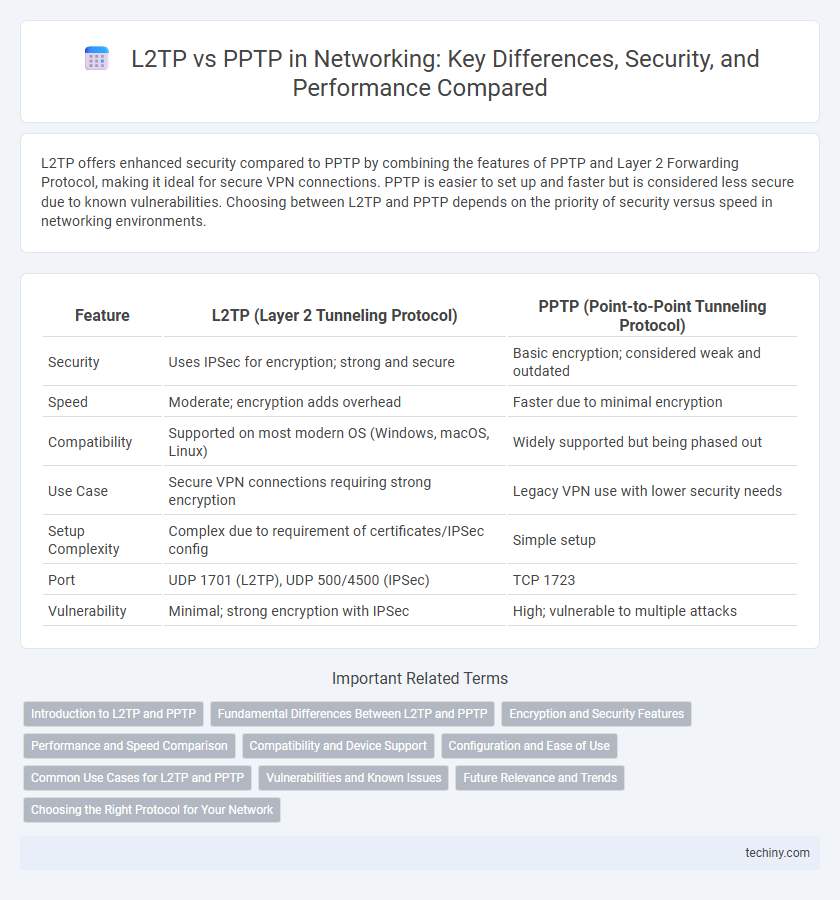L2TP offers enhanced security compared to PPTP by combining the features of PPTP and Layer 2 Forwarding Protocol, making it ideal for secure VPN connections. PPTP is easier to set up and faster but is considered less secure due to known vulnerabilities. Choosing between L2TP and PPTP depends on the priority of security versus speed in networking environments.
Table of Comparison
| Feature | L2TP (Layer 2 Tunneling Protocol) | PPTP (Point-to-Point Tunneling Protocol) |
|---|---|---|
| Security | Uses IPSec for encryption; strong and secure | Basic encryption; considered weak and outdated |
| Speed | Moderate; encryption adds overhead | Faster due to minimal encryption |
| Compatibility | Supported on most modern OS (Windows, macOS, Linux) | Widely supported but being phased out |
| Use Case | Secure VPN connections requiring strong encryption | Legacy VPN use with lower security needs |
| Setup Complexity | Complex due to requirement of certificates/IPSec config | Simple setup |
| Port | UDP 1701 (L2TP), UDP 500/4500 (IPSec) | TCP 1723 |
| Vulnerability | Minimal; strong encryption with IPSec | High; vulnerable to multiple attacks |
Introduction to L2TP and PPTP
L2TP (Layer 2 Tunneling Protocol) and PPTP (Point-to-Point Tunneling Protocol) are widely used VPN protocols that enable secure remote access by creating encrypted tunnels over IP networks. L2TP combines features of PPTP and Layer 2 Forwarding (L2F), offering enhanced security through integration with IPSec for encryption and authentication. PPTP is an older protocol known for its simplicity and fast setup but provides weaker security compared to L2TP, making L2TP the preferred choice for more secure VPN connections.
Fundamental Differences Between L2TP and PPTP
L2TP (Layer 2 Tunneling Protocol) encapsulates data twice by combining PPP with IPsec for enhanced security, whereas PPTP (Point-to-Point Tunneling Protocol) uses GRE to tunnel PPP frames with weaker encryption. L2TP operates at Layer 2 of the OSI model, supporting multiple protocols and offering better VPN stability and compatibility. PPTP, running at Layer 2 as well, prioritizes speed and ease of setup but is vulnerable to modern security threats due to outdated encryption standards.
Encryption and Security Features
L2TP (Layer 2 Tunneling Protocol) combined with IPsec provides strong encryption using AES with 256-bit keys, ensuring robust security for VPN connections. PPTP (Point-to-Point Tunneling Protocol) relies on MS-CHAP-v2 authentication and employs weaker encryption standards like MPPE with 128-bit keys, making it more vulnerable to attacks. L2TP/IPsec supports advanced security features such as data integrity, confidentiality, and anti-replay protection, while PPTP lacks modern encryption safeguards.
Performance and Speed Comparison
L2TP (Layer 2 Tunneling Protocol) generally offers better performance than PPTP (Point-to-Point Tunneling Protocol) due to its enhanced security features and support for higher encryption standards, which can slightly reduce speed but provide more stability and reliability. PPTP, being an older protocol, often delivers faster connection speeds with lower overhead but is less secure and more vulnerable to cyberattacks. For environments prioritizing speed over robust security, PPTP may be preferable, whereas L2TP suits scenarios demanding a balance between secure performance and efficient data transfer.
Compatibility and Device Support
L2TP offers broader compatibility across modern operating systems including Windows, macOS, Linux, iOS, and Android, ensuring seamless integration with most network devices. PPTP provides limited support on newer platforms due to security vulnerabilities, with primary functionality retained on legacy systems such as older Windows versions. Networking professionals often prefer L2TP for its enhanced device support and interoperability in diverse network environments.
Configuration and Ease of Use
L2TP offers more secure and flexible configuration options compared to PPTP, supporting stronger encryption protocols and easier integration with modern VPN clients. PPTP requires minimal setup, making it user-friendly but less secure due to its weaker encryption standards. Network administrators often prefer L2TP for enterprise environments where enhanced security and reliable authentication are critical.
Common Use Cases for L2TP and PPTP
L2TP is commonly used for secure remote access and site-to-site VPN connections due to its strong encryption when combined with IPsec, making it ideal for businesses requiring robust security. PPTP, favored for its simplicity and fast connection setup, is often employed in legacy systems and less security-critical environments such as personal VPNs or quick remote access scenarios. Enterprises prioritize L2TP for corporate VPNs, whereas PPTP suits basic tunneling needs where minimal encryption suffices.
Vulnerabilities and Known Issues
L2TP offers stronger security than PPTP by combining IPsec for encryption, but it is vulnerable to certain attacks like spoofing and DoS if improperly configured. PPTP is widely regarded as less secure due to its reliance on MS-CHAPv2 authentication, which is susceptible to brute force and dictionary attacks. Both protocols face compatibility challenges and performance issues, but PPTP's vulnerabilities have led to its deprecation in many modern networks.
Future Relevance and Trends
L2TP (Layer 2 Tunneling Protocol) is gaining future relevance with increased adoption in secure VPN solutions due to its compatibility with IPsec, offering stronger encryption and better security than PPTP (Point-to-Point Tunneling Protocol). PPTP is becoming obsolete as its security vulnerabilities render it unsuitable for modern network environments and it lacks support for contemporary encryption standards. Trends in networking favor protocols like L2TP combined with IPsec or newer VPN technologies such as WireGuard, emphasizing enhanced security, performance, and scalability.
Choosing the Right Protocol for Your Network
L2TP (Layer 2 Tunneling Protocol) offers stronger security through IPsec encryption compared to PPTP (Point-to-Point Tunneling Protocol), which is simpler but more vulnerable to attacks. Networks requiring robust data protection and compliance often prefer L2TP due to its better encryption standards and support for multiple authentication methods. For legacy systems or environments demanding faster setup with minimal configuration, PPTP remains a choice despite its weaker security profile.
L2TP vs PPTP Infographic

 techiny.com
techiny.com